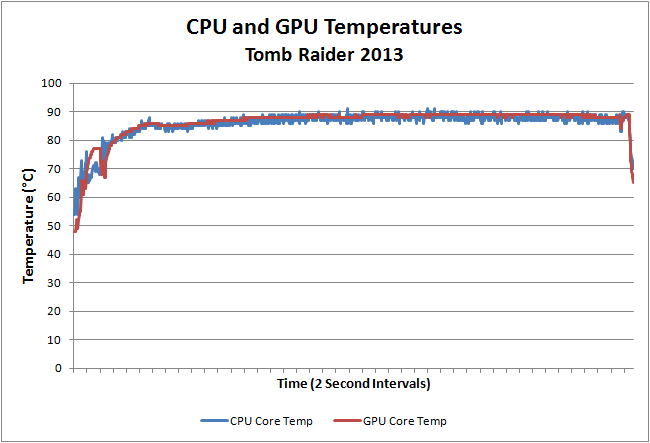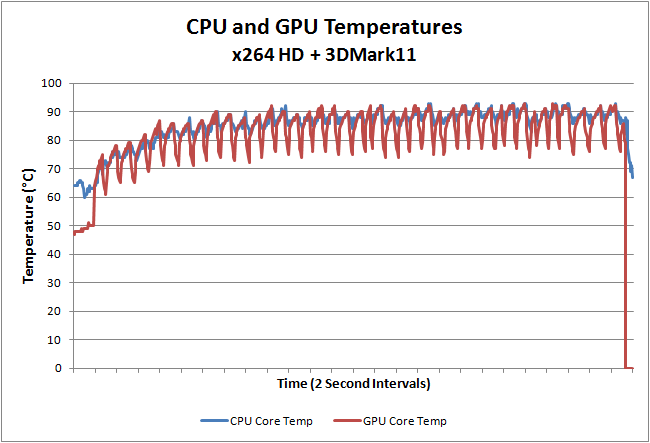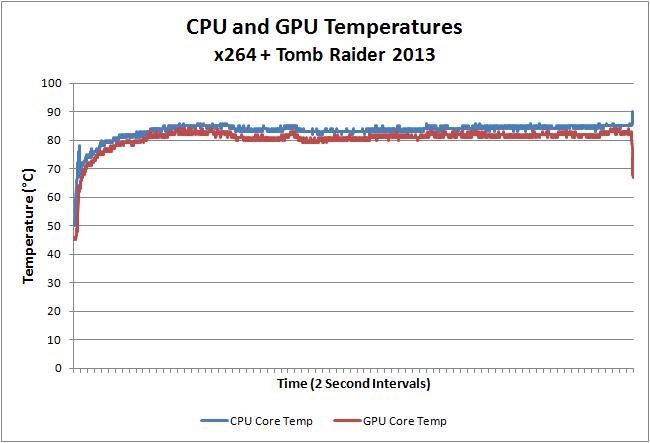Acer V7-482PG-9884 Review: Everything You Need
by Jarred Walton on August 24, 2013 12:00 AM ESTTemperatures
What happens to a slim, reasonably light, and reasonably powerful laptop when you put a sustained heavy load on the CPU and GPU? This is an area where we’ve seen quite a few laptops fall short; either they throttle CPU and/or GPU performance to cope with the heat (e.g. Dell’s XPS 15), or they get really hot – sometimes both! Logging CPU and GPU temperatures (and clock speeds) while the Aspire V7 runs a game (Tomb Raider), we get the following chart. (Note that the measurements are sampled at two second intervals, but the distance between hash marks on the x-axis is closer to one minute.)

Under most common gaming loads, in a matter of 10-15 minutes the V7 will reach the point where temperatures and clocks stabilize. In this case, the CPU and GPU temperatures are typically just under 90C, though the CPU did peak at 91C. That isn’t spectacular but it’s actually not too bad compared to other Ultrabooks that we’ve tested – Ultrabooks that didn’t have a dGPU. As far as clock speeds are concerned, the GPU stayed at a steady 1162.7MHz core/1800MHz RAM throughout the testing, so there’s no throttling on that part. Meanwhile, the CPU started at 2700-3000MHz (maximum Turbo Boost was achieved), and after a few minutes it settled into a comfortable 2400-2500MHz. (On a related note, stress testing with OCCT on the GPU caused the GPU to throttle down to a 758MHz core clock, so it was actually less strenuous than running a game like Tomb Raider.)

For our next stress test, we ran the x264 HD 5.0 encode on one CPU core (two threads) and 3DMark11 looping the four graphics tests on the GPU. This isn’t necessarily a worst-case stress test, but it’s the sort of load that we expect any well-designed system to handle without CPU temperatures breaking 95C (and preferably staying under 85C). The V7 does manage to stay under 95C, but just barely; we see temperatures of 93C on the CPU and 92C on the GPU within 10 minutes of launching our stress test, at which point the system basically enters steady-state – the GPU cools off a bit during scene transitions (analogous to level loads), and the CPU clock speeds range between 2100 MHz and 2700 MHz. So again the CPU isn’t running at maximum Turbo speed the whole time, but it does stay above the minimum guaranteed 1.8 GHz.

As a final stress test, the above is a plot of temperatures while running x264 HD with Tomb Raider – there’s no loading of levels this time, so the GPU is under a continuous load. The result is actually less demanding than the above stress test, at least in terms of temperatures, so apparently 3DMark11 manages to hit the GPU harder than Tomb Raider. Without the breaks between 3DMark11 scenes we don’t see any cyclical cooling down of the CPU and GPU, but the CPU clocks settle down at 2000-2100MHz this time while the GPU stays at the same 1163/1800MHz. The maximum temperature of the CPU this time is 87C – it actually gets hotter without the load on the GPU. The GT 750M meanwhile tops out at 84C.
I discussed overclocking of the GPU RAM a couple pages back, and you might be wondering what that does to the core temperatures. The answer: surprisingly little. I logged temperatures and clock speeds while running through our entire gaming suite, with very little idle time in between benchmarks. Throughout the entire set of benchmarks, the maximum CPU temperature was 87C and the maximum GPU temperature was 88C. I'd expect maybe a couple of degrees more than running at stock clocks, but GPU Boost may back off a little at times due to the increased power/heat from the GPU RAM, resulting in pretty much no significant change.
In the end, while we’d be happier with lower temperatures than what we’re seeing, the V7 still manages to deliver very good performance in a compelling form factor. The dual cooling fans with shared heatpipes appear to cope with the heat levels well enough for sustained use, though I’d recommend keeping the laptop on a desk or other flat surface when gaming or doing other computationally intensive work as the bottom of the V7 gets fairly toasty under load (mostly in the back-center area). Having the V7 on your lap will also tend to block the air intakes that are located on the bottom, right where the laptop would be resting on your thighs. It's not a problem for casual use, but under load it's pretty warm.
Noise Levels
There’s generally a close relationship between temperatures and noise levels; some laptops spin their fans faster and generate more noise in order to keep temperatures down, while others let the CPU and GPU get a little warmer in the hopes of reducing noise levels. The Acer V7 is better than most laptops in that maximum noise output during stress testing and gaming is 38.3dB, while at idle the laptop is generally silent (or at least below the 30dB noise floor of my equipment and location). The use of two apparently lower RPM fans instead of a single fan helps here as well.
I did cover both of the vents while running Tomb Raider to see if I could trigger a higher fan speed, but I was unable to do so – for better or worse, the fans appear to be maxed out at 38dB. Even temperatures weren’t any worse with covered vents; instead, the GPU clocks dropped slightly to 967MHz, which apparently was enough to keep the system below 90C. If you happen to be in a hotter environment (like Brian in Arizona during the summer), the V7 may run a bit slower to deal with the added heat, but it’s not a major concern. For reference, my testing location in Washington ranged from 60-90F (15-32C), so while a 50C ambient temperature would be far less accommodating, I can’t say that shag carpet with a towel covering the exhausts is any better suited for running games on a laptop.










62 Comments
View All Comments
JarredWalton - Saturday, August 24, 2013 - link
The "silliness" was more in reference to the hidden torx screws under the pads. Let me clarify that in the text.evilspoons - Saturday, August 24, 2013 - link
Yes! Torx screws are better given the same physical size, and the screwdrivers aren't exactly expensive or anything. I'd much rather have to spend an extra five minutes finding a Torx driver than strip out a friggin' Philips.KaarlisK - Saturday, August 24, 2013 - link
In 2011, I bought a laptop that weights 1.7kg and has a 35W TDP CPU, and as a result, the CPU and the integrated graphics could actually both boost at the same time.Now we're being offered 1.9-2.5 kilo laptops with 17W CPUs and rather inconsistent performance, especially in games.
It seems silly, especially since the idle power consumption is the mostly same and the prices, at least for Ivy Bridge, were mostly similar.
mtoma - Saturday, August 24, 2013 - link
I think Jarred (and many other ethusiasts) have huge expectations from the displays. Sure, everybody wants 1080p (or higher) IPS displays, but at what cost? Let's not forget that many people don't have many thousands of dollars per month in order to afford such beautiful displays/products. For example, why should'nt be enough an 720p or IPS panel on a 14 or 15 inch laptop? I remember back in 2007 I had an 15,6 inch Fujitsu laptop with a 1280x800 pixels. It wasn't great at all, but it was getting the work done. Remember, a greater display resolution demands much more from the graphichs, and that leads to bigger power consumption. More doesn't always mean better.Regards,
KaarlisK - Saturday, August 24, 2013 - link
A better display is simply _the_ worthwhile upgrade in the era of "good enough" computing.I have a Sandy i3 laptop and a Core 2 Duo desktop, and since I do not much game (or convert videos/run scientific simulations), I still do not feel a need to upgrade my CPU (I do have fast storage and lots of RAM).
More and more I've been catching myself on the thought that my next upgrade might be a ~24'' monitor with high DPI, if one arrives for a reasonable price. With the laptop it is similar – it does everything it is asked to, so the only incentive to upgrade is either a way better screen (better colors and high DPI), or the same performance and OS support in a tablet/phone sized package.
sheh - Saturday, August 24, 2013 - link
Nevermind the resolution, a poor TN is a horrible thing. I'd want laptop makers to use *decent* TNs as minimum, though really I'd prefer something better than TN (with decent response pixel times).I recently got an Asus 15.6" laptop (500-600$ in the US). The TN screen is horrendous. The specs say it's something like 15+30 degrees vertically, but that's a lie. It's more like 0 degrees. There's no single angle where you can see the whole screen undistorted. Maybe if you watch it from 2-3 meter away. Horizontal angles aren't good either, but are less of a problem. I wonder why they don't rotate the panel 90 degrees, as vertical is more important in laptops. The 6-bit dithering is not difficult to notice. The pixel response time isn't too good. And looking at technical specs, it seems there are even worse TN screens being made!
Now, you can get such panels on eBay for about $50. That's for a very poor 6-bit 1366x768 TN. For $150 you can get a 15.6" 1920x1080 S-IPS 10-bit. $100 difference in end user price going from super poor to very good:
http://www.ebay.com/itm/New-15-6-Laptop-LCD-Screen...
You can probably find decent 6-bit 1366x768 IPSes for less than $100.
sheh - Saturday, August 24, 2013 - link
BTW, I didn't say anything about contrast because I don't know what it is. The contrast is variable across the screen (mostly vertically), as are the colors (is this pink or orange? is it dark purple or light? is there a vertical gradient here or is it a solid color?).Pfffman - Saturday, August 24, 2013 - link
I don't think Jarred expects people to buy laptops monthly let alone every year so investing in a nicer screen is still reasonable.When the asking price for the laptop is $1300, 1080 would seem to be expected. Touch is a nice extra. Generally Anandtech will scale their screen expectations according to price. They do have a high emphasis on screen though. They generally only okay TN panels if they are the really good ones or the laptop is clearly budget targeted.
In this time, it might be hard to get a 1280x720 or 1280x800 IPS screen at 14 inch. The panel manufacturers might not bother with it any more.
piroroadkill - Sunday, August 25, 2013 - link
While your old laptop may have had a crap display - many others had old laptops which did not. I have a laptop from 2004~ that has a 15" 1920x1200 screen, a Dell Precision which also has a 15" 1920x1200 screen, an old Dell with a 1400x1050 14".. etc.My favourite laptop and the one I'm on right now is a Sony Vaio Z12, 13.3" 1600x900, and so light. But I added the previous examples to show that some people have ALREADY had higher res screens, and are bewildered that options lack today.
I think the screen on this particular Acer is probably just fine - once calibrated, so they probably should do that from the factory - but I honestly would love to drop the touchscreen entirely, and have a matte finish. But that's me. It would even save some money.
dareo - Saturday, August 24, 2013 - link
"The V7-582PG-6421 has a 15.6” 1080p IPS display, but the CPU is a Core i5-4200U and the GPU is a rather questionable GT 720M"I've been considering this model mainly because of the larger display, which only adds 0.5 lbs to the weight, and my eyes aren’t what they used to be so the extra screen real estate is needed. It would be great if it were as light as some previous generations of the Samsung Series 9, but you can’t have everything.
Taking into account the following use cases, will the lower CPU & GPU specs on the 6421 really make a difference to me?:
At home office (connected to an external 24” monitor):
- Word, Excel, Powerpoint
- email
- web browsing
- occasional hobbyist use of 3D Home Architect
On the road:
- Word, Excel, Powerpoint
- email
- web browsing
- watching videos on flights
While display size at home is irrelevant since I have the external monitor, I find that my current laptop with a 13.3” display doesn’t cut it (for me) on the road when working with the MS-Office suite. Since the laptop is nearly 4 years old and starting to give me some problems, the timing of the new Haswell-based laptops is spot on and I’m looking to get one by the end of the year. Right now there just doesn’t seem to be too many options for a new generation (processor & touchscreen) 15” minimal-compromise ultrabook at a decent price. Calling the V7-582PG-6421 an ultrabook might be a stretch, but it weights the same as my current smaller-screen laptop so it’s acceptable.
Should I be waiting for something else that’s just on the horizon? Are there other alternatives to the V7-582PG-6421 that I should be considering?